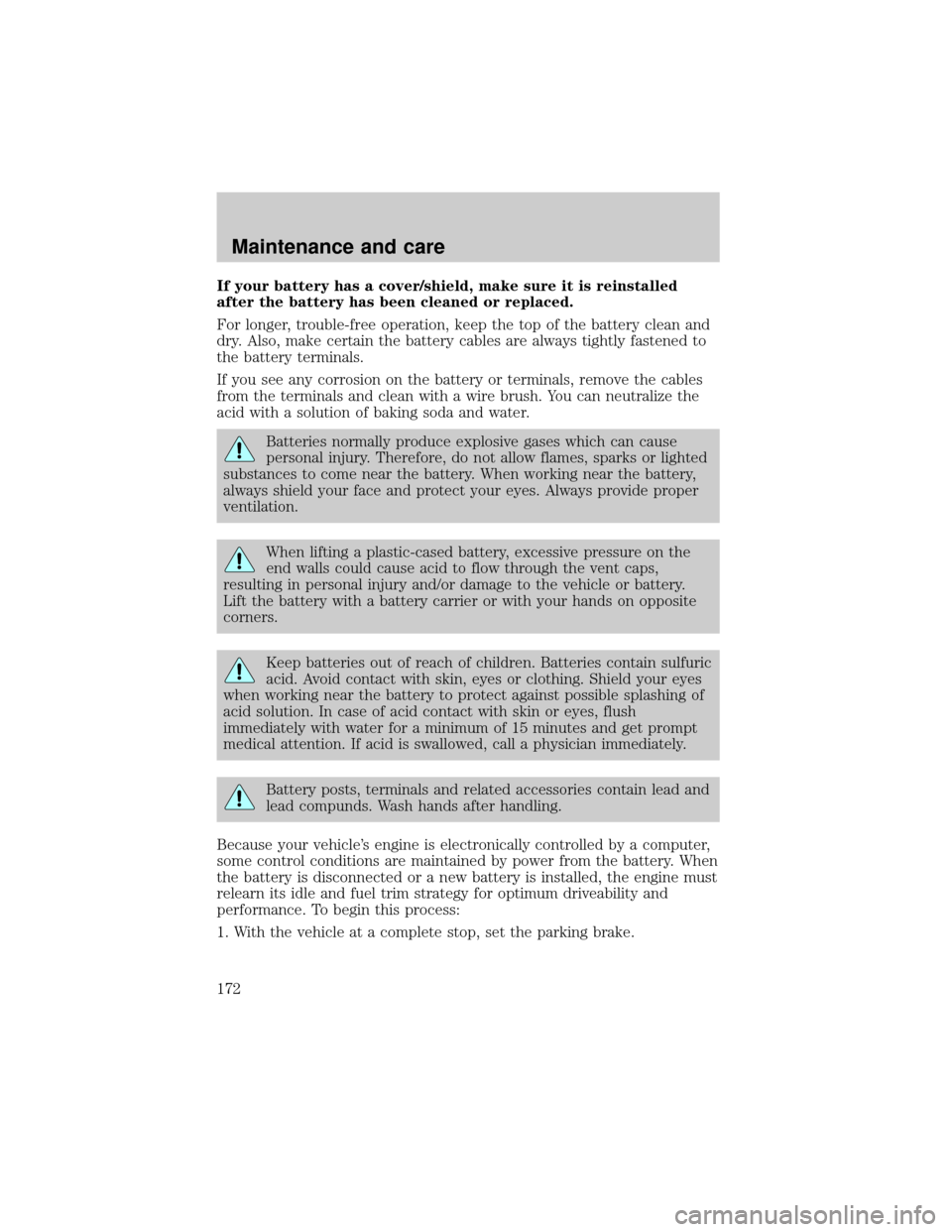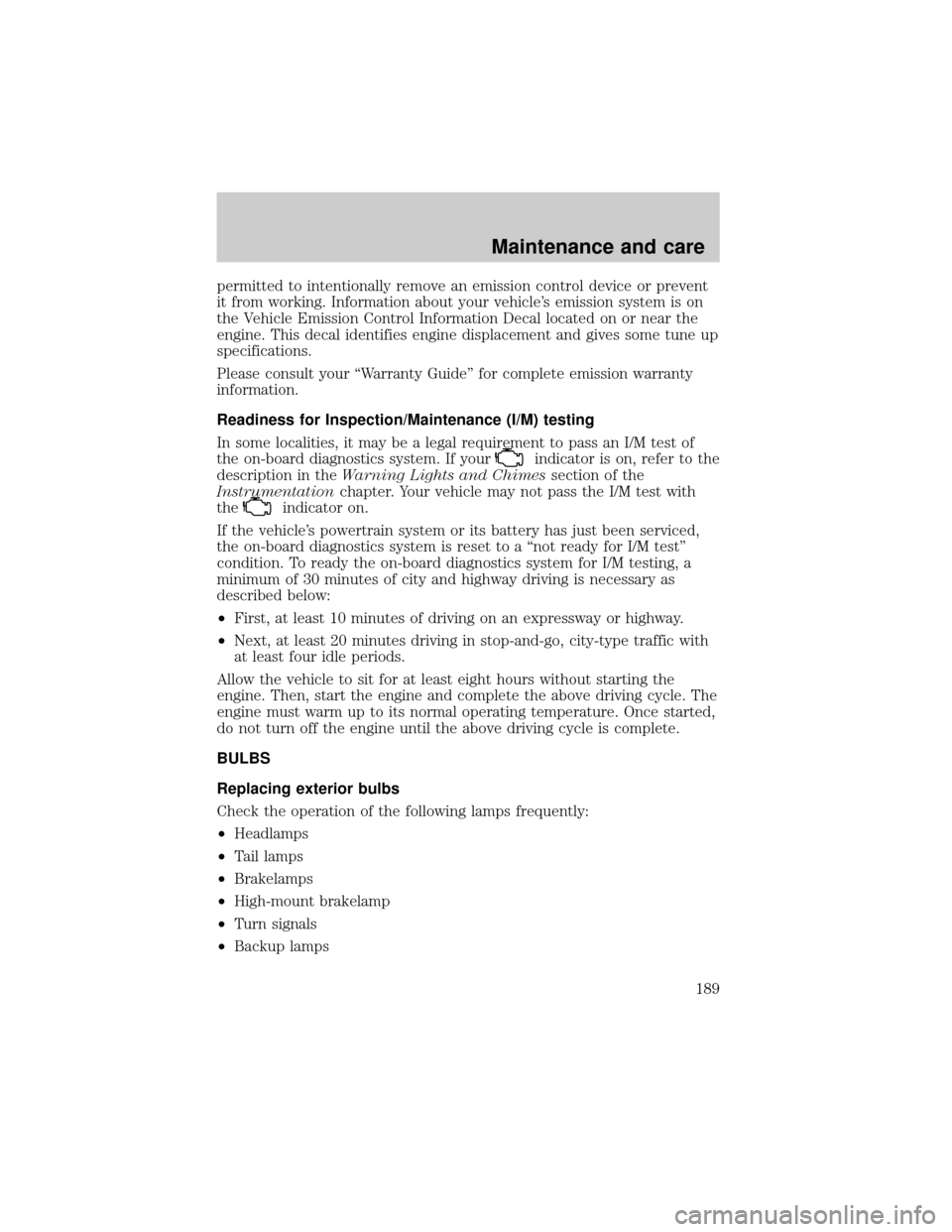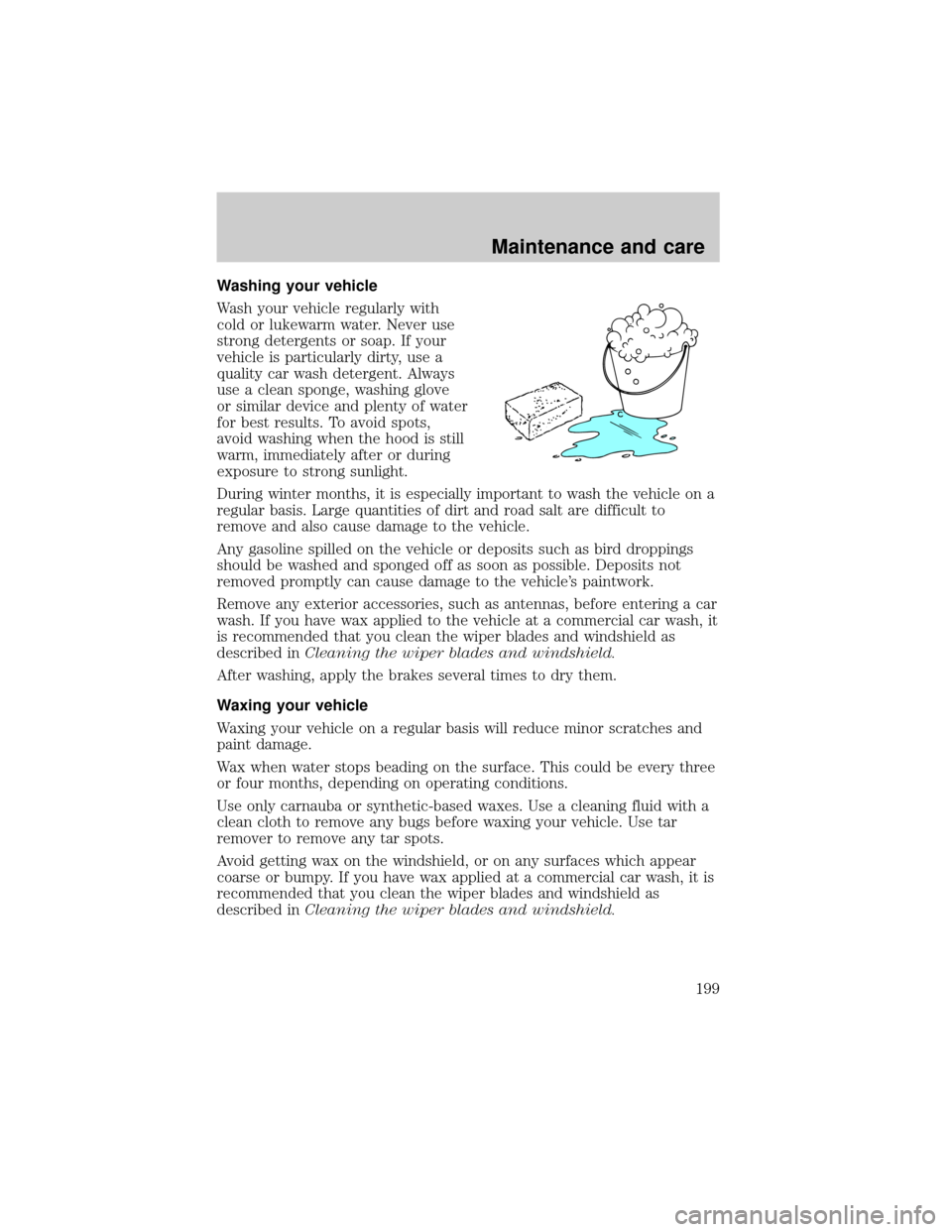2000 FORD TAURUS brake light
[x] Cancel search: brake lightPage 148 of 232

SERVICE RECOMMENDATIONS
To help you service your vehicle:
²We highlight do-it-yourself items in the engine compartment for easy
location.
²We provide a Scheduled Maintenance Guide which makes tracking
routine service easy.
If your vehicle requires professional service, your dealership can provide
necessary parts and service. Check your ªWarranty Guideº to find out
which parts and services are covered.
Use only recommended fuels, lubricants, fluids and service parts
conforming to specifications. Motorcraft parts are designed and built to
provide the best performance in your vehicle.
PRECAUTIONS WHEN SERVICING YOUR VEHICLE
Be especially careful when inspecting or servicing your vehicle.
²Do not work on a hot engine.
²When the engine is running, keep loose clothing, jewelry or long hair
away from moving parts.
²Do not work on a vehicle with the engine running in an enclosed
space, unless you are sure you have enough ventilation.
²Keep all lit cigarettes, open flames and other lit material away from
the battery and all fuel related parts.
If you disconnect the battery, the engine must ªrelearnº its idle
conditions before your vehicle will drive properly, as explained in the
Batterysection in this chapter.
Working with the engine off
1. Set the parking brake, and ensure the gearshift is securely latched in
park.
2. Turn off the engine and remove the key.
3. Block the wheels to prevent the vehicle from moving unexpectedly.
Working with the engine on
1. Set the parking brake and ensure the gearshift is securely latched in
P (Park).
2. Block the wheels to prevent the vehicle from moving unexpectedly.
Maintenance and care
148
Page 172 of 232

If your battery has a cover/shield, make sure it is reinstalled
after the battery has been cleaned or replaced.
For longer, trouble-free operation, keep the top of the battery clean and
dry. Also, make certain the battery cables are always tightly fastened to
the battery terminals.
If you see any corrosion on the battery or terminals, remove the cables
from the terminals and clean with a wire brush. You can neutralize the
acid with a solution of baking soda and water.
Batteries normally produce explosive gases which can cause
personal injury. Therefore, do not allow flames, sparks or lighted
substances to come near the battery. When working near the battery,
always shield your face and protect your eyes. Always provide proper
ventilation.
When lifting a plastic-cased battery, excessive pressure on the
end walls could cause acid to flow through the vent caps,
resulting in personal injury and/or damage to the vehicle or battery.
Lift the battery with a battery carrier or with your hands on opposite
corners.
Keep batteries out of reach of children. Batteries contain sulfuric
acid. Avoid contact with skin, eyes or clothing. Shield your eyes
when working near the battery to protect against possible splashing of
acid solution. In case of acid contact with skin or eyes, flush
immediately with water for a minimum of 15 minutes and get prompt
medical attention. If acid is swallowed, call a physician immediately.
Battery posts, terminals and related accessories contain lead and
lead compunds. Wash hands after handling.
Because your vehicle's engine is electronically controlled by a computer,
some control conditions are maintained by power from the battery. When
the battery is disconnected or a new battery is installed, the engine must
relearn its idle and fuel trim strategy for optimum driveability and
performance. To begin this process:
1. With the vehicle at a complete stop, set the parking brake.
Maintenance and care
172
Page 187 of 232

²Resting your foot on the brake pedal while driving may reduce fuel
economy.
²Combine errands and minimize stop-and-go driving.
Maintenance
²Keep tires properly inflated and use only recommended size.
²Operating a vehicle with the wheels out of alignment will reduce fuel
economy.
²Use recommended engine oil. Refer toLubricant Specifications.
²Perform all regularly scheduled maintenance items. Follow the
recommended maintenance schedule and owner maintenance checks
found in your vehicle Scheduled Maintenance Guide.
Conditions
²Heavily loading a vehicle or towing a trailer may reduce fuel economy
at any speed.
²Carrying unnecessary weight may reduce fuel economy (approximately
0.4 km/L [1 mpg] is lost for every 180 kg [400 lb] of weight carried).
²Adding certain accessories to your vehicle (for example bug
deflectors, rollbars/light bars, running boards, ski/luggage racks) may
reduce fuel economy.
²Using fuel blended with alcohol may lower fuel economy.
²Fuel economy may decrease with lower temperatures during the first
12±16 km (8±10 miles) of driving.
²Driving on flat terrain offers improved fuel economy as compared to
driving on hilly terrain.
²Transmissions give their best fuel economy when operated in the top
cruise gear and with steady pressure on the gas pedal.
²Close windows for high speed driving.
EPA window sticker
Every new vehicle should have the EPA window sticker. Contact your
dealer if the window sticker is not supplied with your vehicle. The EPA
window sticker should be your guide for the fuel economy comparisons
with other vehicles.
It is important to note the box in the lower left corner of the window
sticker. These numbers represent the Range of L/100 km (MPG)
Maintenance and care
187
Page 189 of 232

permitted to intentionally remove an emission control device or prevent
it from working. Information about your vehicle's emission system is on
the Vehicle Emission Control Information Decal located on or near the
engine. This decal identifies engine displacement and gives some tune up
specifications.
Please consult your ªWarranty Guideº for complete emission warranty
information.
Readiness for Inspection/Maintenance (I/M) testing
In some localities, it may be a legal requirement to pass an I/M test of
the on-board diagnostics system. If your
indicator is on, refer to the
description in theWarning Lights and Chimessection of the
Instrumentationchapter. Your vehicle may not pass the I/M test with
the
indicator on.
If the vehicle's powertrain system or its battery has just been serviced,
the on-board diagnostics system is reset to a ªnot ready for I/M testº
condition. To ready the on-board diagnostics system for I/M testing, a
minimum of 30 minutes of city and highway driving is necessary as
described below:
²First, at least 10 minutes of driving on an expressway or highway.
²Next, at least 20 minutes driving in stop-and-go, city-type traffic with
at least four idle periods.
Allow the vehicle to sit for at least eight hours without starting the
engine. Then, start the engine and complete the above driving cycle. The
engine must warm up to its normal operating temperature. Once started,
do not turn off the engine until the above driving cycle is complete.
BULBS
Replacing exterior bulbs
Check the operation of the following lamps frequently:
²Headlamps
²Tail lamps
²Brakelamps
²High-mount brakelamp
²Turn signals
²Backup lamps
Maintenance and care
189
Page 196 of 232

Using the right bulbs
Replacement bulbs are specified in the chart below. Headlamp bulbs
must be marked with an authorized ªD.O.T.º for North America and an
ªEº for Europe to assure lamp performance, light brightness and pattern
and safe visibility. The correct bulbs will not damage the lamp assembly
or void the lamp assembly warranty and will provide quality bulb burn
time.
FunctionNumber of
bulbsTrade Number
Front park/turn lamp 23457 NAK
(amber)
Headlamp 29007 QL (9007
LL optional)
Tail lamp/brake/turn lamp 2 3157
Tail lamp/brake lamp (wagon) 2 3157
Rear turn lamp (wagon) 2 3456K
Backup lamp 2 921
Backup lamp (wagon) 2 3156
License plate lamp 2 168
High-mount brake lamp 2 912
Rear side marker lamp (wagon) 2 168
Cargo lamp (wagon) 1 578
Dome lamp 1 578
Dome/map lamp 3 578
Dome lamp/moon roof 2 578
Visor vanity lamp
(passenger/driver)2 DE 3021
Floor console 2 194
Luggage compartment lamp 1 906
I/P ashtray lamp 1 194
All replacement bulbs are clear in color except where noted.
To replace all instrument panel lights - see your dealer.
Maintenance and care
196
Page 199 of 232

Washing your vehicle
Wash your vehicle regularly with
cold or lukewarm water. Never use
strong detergents or soap. If your
vehicle is particularly dirty, use a
quality car wash detergent. Always
use a clean sponge, washing glove
or similar device and plenty of water
for best results. To avoid spots,
avoid washing when the hood is still
warm, immediately after or during
exposure to strong sunlight.
During winter months, it is especially important to wash the vehicle on a
regular basis. Large quantities of dirt and road salt are difficult to
remove and also cause damage to the vehicle.
Any gasoline spilled on the vehicle or deposits such as bird droppings
should be washed and sponged off as soon as possible. Deposits not
removed promptly can cause damage to the vehicle's paintwork.
Remove any exterior accessories, such as antennas, before entering a car
wash. If you have wax applied to the vehicle at a commercial car wash, it
is recommended that you clean the wiper blades and windshield as
described inCleaning the wiper blades and windshield.
After washing, apply the brakes several times to dry them.
Waxing your vehicle
Waxing your vehicle on a regular basis will reduce minor scratches and
paint damage.
Wax when water stops beading on the surface. This could be every three
or four months, depending on operating conditions.
Use only carnauba or synthetic-based waxes. Use a cleaning fluid with a
clean cloth to remove any bugs before waxing your vehicle. Use tar
remover to remove any tar spots.
Avoid getting wax on the windshield, or on any surfaces which appear
coarse or bumpy. If you have wax applied at a commercial car wash, it is
recommended that you clean the wiper blades and windshield as
described inCleaning the wiper blades and windshield.
Maintenance and care
199
Page 225 of 232

Accessory delay ..........................54
Air bag supplemental
restraint system ................94,95,98
and child safety seats ..............96
description ...........................95,98
disposal ....................................100
driver air bag ..................94,97,99
indicator light ......................12,97
operation .........................94,97,99
passenger air bag ...........94,97,99
side air bag ................................98
Air cleaner filter .......................205
Air conditioning ..........................18
automatic temperature
control system ..........................21
Air filter, cabin ..........................166
Antifreeze
(see Engine coolant) ................157
Anti-lock brake system
(see Brakes) .......................113,114
Anti-theft system ........................64
arming the system ....................64
disarming a triggered system ..66
warning light .............................11
Audio system (see Radio) .........28
Automatic transaxle .................118
driving with .............................120
fluid, adding ............................163
fluid, checking ........................163
fluid, refill capacities ..............206
fluid, specification ..................208
Auxiliary power point .................27
Axle
lubricant specifications ..........207
Battery .......................................171
acid, treating emergencies .....171
charging system
warning light .............................12
jumping a disabled battery ....142
maintenance-free ....................171
replacement, specifications ...205
servicing ..................................171Belt minder .................................90
Brakes ........................................113
anti-lock ............................113,114
anti-lock brake system
(ABS) warning light ..........11,114
brake warning light ..................12
fluid, checking and adding ....155
fluid, refill capacities ..............206
fluid, specifications ..........207,208
lubricant specifications ...207,208
parking ....................................115
pedals (see Power
adjustable foot pedals) ............43
shift interlock ..........................118
Break-in period .............................3
Capacities for refilling fluids ....206
Cargo area shade ........................59
Cargo cover .................................58
Cargo net .....................................58
CD changer .................................38
Cellular telephone
Wireless Interface Module .......51
Certification Label ....................210
Child safety restraints ..............101
child safety belts ....................101
Child safety seats ......................102
attaching with tether straps ..106
in front seat ............................103
in rear seat .......................103,106
Cleaning your vehicle ...............198
engine compartment ..............201
exterior ....................................200
exterior lamps .........................200
instrument panel ....................203
instrument panel lens ............203
interior ..............................203,204
mirrors .....................................200
plastic parts ............................200
safety belts ..............................203
washing ....................................199
waxing .....................................199
wheels ......................................200
Index
225
Page 227 of 232

low fuel warning light ..............10
octane rating ....................182,208
quality ......................................183
running out of fuel .................184
safety information relating to
automotive fuels .....................178
Fuses ...................................133,134
Gas cap (see Fuel cap) ............181
Gas mileage
(see Fuel economy) .................184
Gauges .........................................13
engine coolant
temperature gauge ...................14
fuel gauge ..................................15
odometer ...................................15
speedometer .............................13
tachometer ................................14
trip odometer ............................15
GAWR
(Gross Axle Weight Rating) .....123
definition .................................123
driving with a heavy load ......123
location ....................................123
GVWR (Gross
Vehicle Weight Rating) .............123
calculating ...............................123
definition .................................123
driving with a heavy load ......123
location ....................................123
Hazard flashers .........................131
Head restraints ...........................74
Headlamps ...................................16
aiming ......................................197
autolamp system .......................17
bulb specifications ..................196
daytime running lights .............16
flash to pass ..............................16
high beam ..............................8,16
replacing bulbs .......................190
turning on and off ....................16
warning chime ..........................13
Heating ........................................18heating and
air conditioning system ............18
Hood ..........................................149
Ignition ..................................43,208
Infant seats
(see Safety seats) .....................102
Inspection/
maintenance (I/M) testing .......189
Instrument panel
cleaning ...................................203
cluster ...................................8,203
lighting up
panel and interior .....................17
location of components ..............8
Jump-starting your vehicle ......142
Keyless entry system .................67
autolock .....................................69
keypad .......................................67
locking and unlocking doors ....68
programming entry code .........67
Keys
key in ignition chime ...............13
positions of the ignition ...........43
Lamps
autolamp system .......................17
bulb replacement
specifications chart ................196
cargo lamps ...............................17
daytime running light ...............16
headlamps .................................16
headlamps, flash to pass ..........16
instrument panel, dimming .....17
interior lamps ......................49,50
replacing
bulbs ............189,190,192,193,194
Lane change indicator
(see Turn signal) ........................47
Liftgate ...................................57,61
Lights, warning and indicator ......8
air bag ........................................12
anti-lock brakes (ABS) .....11,114
anti-theft ...................................11
Index
227